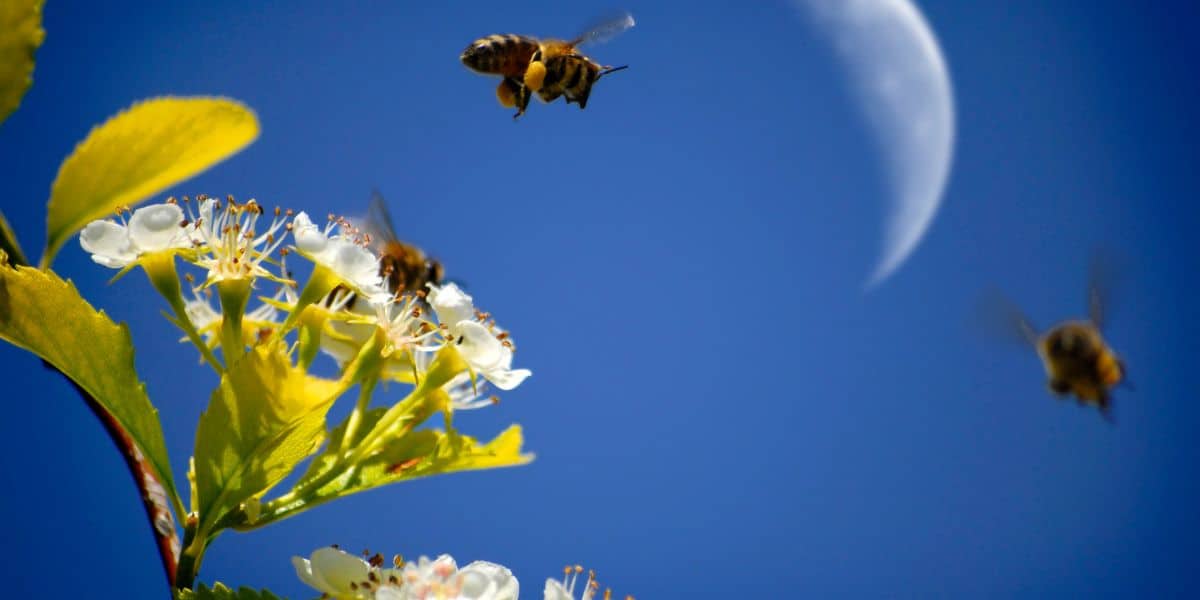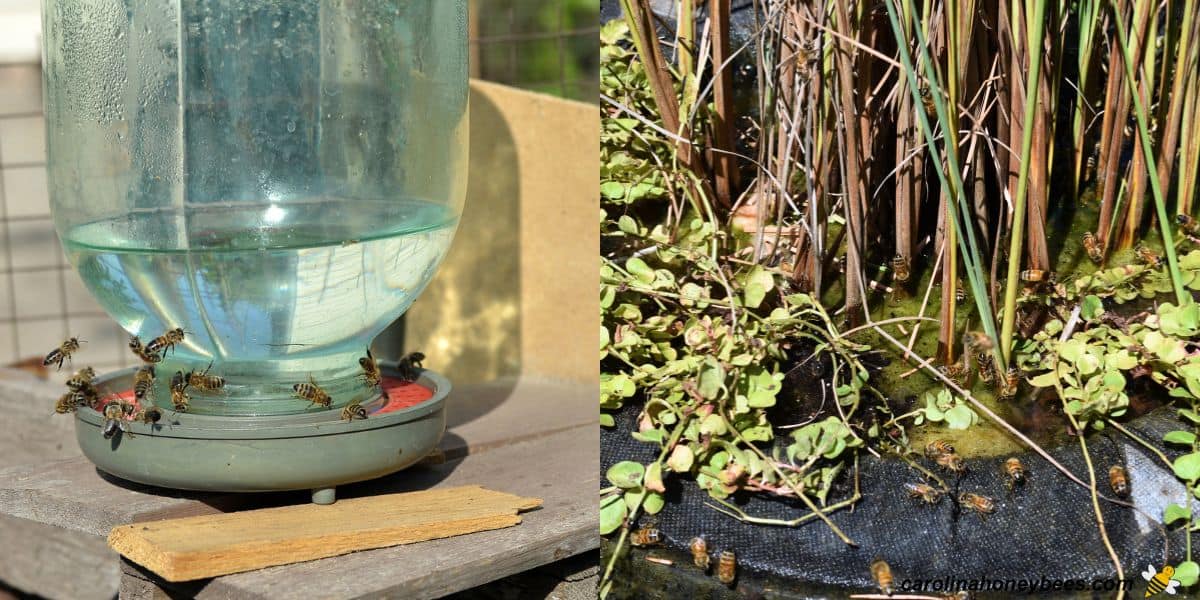How Far do Honey Bees Travel?
Whether you are a new beekeeper or a bee enthusiast – you will likely be interested in how far honey bees travel from their hive. Thousands of worker bees strive to collect needed resources for the colony. And, bees are willing to fly amazing distances to get the job done. By understanding the foraging range of honey bees, beekeepers are better able to make important apiary decisions. So, sit back and let us take a trip (figuratively speaking) into the subject of traveling bees.

Unlike most of the bee species in the world (which are solitary insects), honey bees live in large social colonies. Those female workers serving as foraging bees (or field bees) must hit the sky on every good day looking for food.
How Far do Honey Bees Fly from Their Hive?
Honey bees have some impressive flight abilities despite their small size. Bees typically fly 1 -2 miles from their hive in search of things they need. However, they have the capacity to venture much further.
They need to store a lot of food in order for the bee colony to survive winter. Because of this lifestyle, the honey bee’s foraging range is large – compared to most other insects.

Honey Bee Foraging Range
To understand just how much area the average colony has available consider this: If the colony members forage out 1 mile from the hive in all directions – they have 2,010 acres (813 ha) to explore.
Foragers honey bees can fly 4 miles and in search of pollen and nectar. However, 1-2 miles is the more common average. It is important to remember that how far bees fly from the hive is not data set in stone.
It does reach a point where the energy expended in traveling a far distance outweighs the benefits of the food. Therefore, the quality of any food source plays a role as well.
Honey bees will fly to a rich, easy to harvest food source that is farther away rather than settle for a poor food source nearby. Again, this is about making the best use of their efforts and time.

Scout Bees Aid in Efficient Foraging
We drive our cars to the store to buy what we need – that requires gasoline in most cases. Honey bees need energy too to fuel their travel.
Efficiency is key. To help get the job done, a small percentage of field workers serve as scout bees. They have the unique job of ranging far and wide to find the best food sources and to search out new home locations when needed.
Scout bees will fly more miles than regular members of the colony. When they find a good source of nectar or pollen, they return to the hive and these bees dance to communicate the location of resources.
Nectar vs Pollen
New beekeepers in my online beekeeping classes often want to plant flowers for their bees. No harm in that – though honey bees are pretty good about finding plenty of nectar and pollen.
Yet, the distance of a food source from the hive does play an important role in colony development. The closer food is to the hive, the more of it can be brought back in any given period with less travel time.
A health adult honey bee flies at about 15-20 mph upon first leaving the hive. Once she is loaded down with nectar, pollen, propolis or water she will fly much slower – perhaps around 12 mph.
Distance to Collect Nectar
It is safe to say that honey bees make more journeys to collect nectar than anything else. Bees use nectar to make honey – a vital energy source that it store in the comb inside the hive.
On any given day, most of the field bees will be gathering nectar from millions of blooming plants. Nectar collection often takes place within 2 miles of the hive unless scarcity demands further travel.
Distance Bees Travel to A Pollen Source
Although bees have to capacity to travel a long distance for pollen – this is not the norm. Pollen collection tends to take place within 1 mile or less from the hive.
Perhaps the effort required to bring pollen from a distance far away is not worth the effort? Or maybe it is because though bees need pollen to rear young, they need much more nectar. Maybe they tend to find enough pollen close by.
How Far Bees Fly for Water
We may forget that honey bees need water too! And, much like nectar – they will fly up to 4-5 miles away to find a proper water source.
However, they will gather water from any moist surface – even if the water source is not good quality. This can be a problem if the source is contaminated with pesticides or toxic substances.
This is why it is so important for beekeepers to provide a suitable water source for their bees.

In an apiary with several hives, having a close water source is a big deal. It means that some workers can move on to other tasks instead of putting a massive effort into hauling water all day.
Native bees need water too – though usually in smaller quantities than a honey bee hive. Having a consistent water source in your bee friendly garden is a great idea for all pollinators.
Crop Pollination and Bee Foraging Distance
Migratory beekeepers must consider the foraging distance of honey bees when placing their hives. Not having other crops within flight range also helps to keep the hives focused on the target field.
Pesticide use on agricultural fields must also take bee flight patterns into consideration. The beekeeper providing pollination in a field wants to be sure the farmer doesn’t spray dangerous chemical too near the beehives.
Understanding how far bees fly on average also helps the farmer know how many hives are needed to pollinate a certain size field or fields.
How Far Does a Bee Fly in it’s Lifetime?
Wondering how far a bee travels in its lifetime is one of those fun bee facts questions we love to ponder.
Honestly, too many variables come into play to give a solid answer: available forage near the hive, weather conditions and the health of the colony all play a role.
However, just for fun. An average worker bee produces about 1/12 of a teaspoon of honey in her lifetime. This is why it takes so many individual members to support the colony.
But, if one forager could do all the work – it is estimated that she would have to fly 50,000 – 90,000 miles to make 1 pound of honey (per Honey Association). Given that honey bee workers live about 6 weeks during Summer – that’s a lot of frequent flyer miles.
FAQs
With so many factors involved, it is almost impossible to say – but researchers estimate that bees would need to fly around 90,000 miles to produce a pound of honey.
Honey bees are capable of flying quite high. But, air at higher altitudes becomes colder – eventually she would not be able to maintain enough heat in her flight muscles to stay up. Besides, they don’t need to fly higher than the tallest trees bees love. within reach.
In general, a bee will forage up to 2 miles from the hive easily – but the distance can be much more if conditions warrant.
Honey bee swarming is a natural occurrence where part of the colony leaves to form a new home. In most cases, the swarm travels at least a mile from the mother hive.
Final Thoughts
While the average foraging distance typically ranges from 1 to 3 miles, honey bees are capable of traveling much further under certain conditions. It is dangerous work too – Any bee that travels away from the hive may be attacked by another insect – even birds eat bees. It’s a rough life out there. Understanding the basics of bee foraging helps beekeepers make good decisions about hive placement and management.
Resources:

